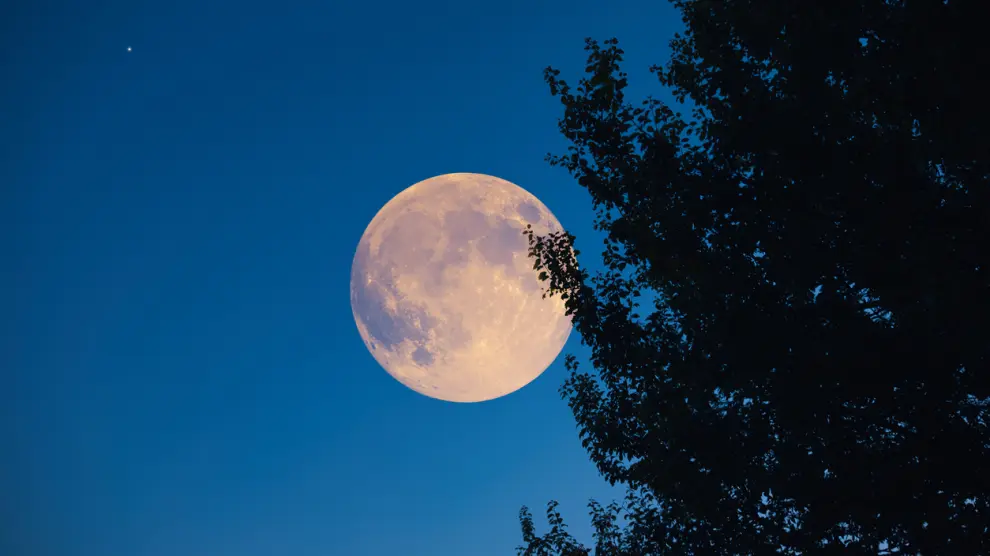The ‘Beaver Moon’ arrives this Wednesday, November 5, to give one of the most awaited astronomical spectacles of the year. On this occasion, the Earth’s natural satellite will be in its perigee phase, that is, at the closest point to our planet ( 356,833 kilometers away), which will cause a supermoon. The phenomenon will make it appear between 7% and 14% larger and up to 30% brighter than a normal full moon.
The event promises to leave postcard images all over Spain, especially at sunset and in the early evening, when the contrast with the still illuminated sky will enhance its size and golden color.
What time will the ‘Beaver Moon’ be visible in Spain?
The time of appearance of the ‘Beaver Moon’ varies depending on the geographical area, due to the autumn time change and the position of the sun. In the eastern part of the Peninsula, the supermoon will begin to be visible around 17:19 hours, shortly after sunset. In Madrid, it will appear a few minutes later, around 17:30 hours.
In the case of the Canary Islands, being further west, we will have to wait until approximately 18:15 hours to see it peeking over the horizon.
Although it will be visible from dusk, its maximum splendor will occur between 22:00 and 23:00 hours, when the sky is completely dark and the atmosphere offers the best conditions to observe it.
The phenomenon will be prolonged during the night of November 5 to 6, so it can also be enjoyed at dawn on Wednesday, between 6:00 and 7:30 a.m., when the moon will set in the west.
An astronomical phenomenon visible to the naked eye
The ‘Beaver Moon’ can be seen with the naked eye from anywhere in the country. However, experts recommend choosing places with low light pollution to enjoy it more clearly.
The best places to observe it are the so-called Starlight destinations, areas certified for their night sky quality. In Spain, some of the most emblematic ones stand out:
-
La Palma, in the Canary Islands, internationally recognized for its Roque de los Muchachos observatory.
-
Menorca, Biosphere Reserve, with several ideal observation points.
-
Sierra Morena, with astronomical viewpoints in Córdoba and Jaén.
-
The Regional Park of Gredos, in Ávila, with skies free of light pollution.
-
The Montsec mountain range, in Lleida, with its well-known Astronomical Park.
For those who wish to observe finer details of the lunar surface – such as craters or visible “seas” – binoculars or medium-range telescopes will be useful.
The brightness of the Moon and the phenomenon of perigee.
The spectacular brightness of the ‘Beaver Moon’ is not because it emits its own light, but because it reflects the sun’s light. On this occasion, the perigee phenomenon places it closer to the Earth, which intensifies its brightness and makes it appear larger on the horizon.
Throughout the year, the moon passes through several perigee and apogee points (the farthest), but November’s is the closest in 2025, making it the brightest and largest supermoon of the year.
This visual effect is most noticeable at moonrise or moonset, when the moon is close to the horizon and its apparent size is amplified by an optical illusion known as the “lunar effect”.
Why is it called ‘Beaver Moon’?
The name ‘Beaver Moon’ has its origins in Native American cultures, which named the full moons of each month after the natural cycles and activities of the season.
There are two main theories about the origin of the name:
-
November was believed to be the month when beavers built their pre-winter dams in preparation for the cold weather.
-
Or, that the hunters called it that way because it coincided with the time when the beavers’ fur was thickest and most valuable, intensifying their capture to obtain skins before the frosts.
However, this astronomical phenomenon receives other names in different cultures. In Spain and Europe it is also known as the “Frost Moon” or “Ice Moon”, because it coincides with the arrival of the first frosts. In China, it is the “White Moon”, and for the Celts, the “Dark Moon”. In the southern hemisphere, where spring is celebrated, it is called the “Corn Moon”, “Flower Moon”, “Milk Moon” or “Hare Moon”, depending on local traditions.
How to photograph the supermoon
The ‘Beaver Moon’ offers a unique opportunity for night photography lovers. Experts advise capturing it during its rising or setting, when it is close to the horizon and can be composed next to landscapes, monuments or buildings to highlight its size.
The use of a tripod and a camera with a telephoto lens allows you to obtain sharper images. In case of using a cell phone, the ideal is to reduce the exposure to prevent excessive brightness from burning the details of the lunar disk.










